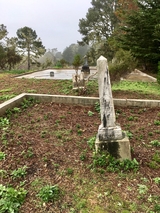As you meander along the coastal bluffs on the Cowell-Purisima Trail you’ll get a chance to walk through several different points in California history.
Ohlone Village Site
About halfway through the trail coming from either the North or the South you will hit Purisima Creek. On the northside of the creek was the site of an Ohlone Village that may have existed for up to 10,000 years. Although there are no remnants of this site today, there are written descriptions of this Village and the people who lived here in journal entries recorded during the Portola Expedition. The Portola Expedition consisted of the first European explorers to find the San Francisco Bay and travel along the San Mateo Coast by land. On October 29th, 1769 as they were searching for Half Moon Bay they came across. There is an effort underway to create an Ohlone-Portola Heritage trail, a 90-mile trail that would follow the route the Portola Expedition covered to reach the San Francisco Bay.
Purisima Ghost Town
At Purisima Creek there is also evidence of a more recent settlement. If you were to follow the Purisima Creek a little bit less than a mile upstream you would see an old cemetery, composed of a handful of tombstones that have been overtaken by vegetation. This is all that remains of the once thriving coastal town of Purisima.

Purisima was established by Henry Dobbel, a German immigrant, who owned the first waffle restaurant in San Francisco. He used the wealth he gained from the restaurant to finance building many of the buildings in the town. From the 1870s to the 1920s it was one of the biggest towns on the Northern California Coast. Unfortunately, Purisima experienced years of crop failure and a decline in logging, which forced most of its residents to move to the city of Spanish-town (now called Half Moon Bay) by the 1920s.
Ocean Shore Railroad
The tracks of the Ocean Shore Railroad would have passed right next to the Cowell-Purisima Trail. The vision of the Ocean Shore Railroad was to transport people from San Francisco all the way down the coast to Santa Cruz, but it was never fully completed and the line stopped near Tunitas Creek. Construction on the railroad began in 1905, and by 1908 over 3,000 people per weekend were taking the train down the coast from San Francisco. The town of Purisima was once one of the stops, you can see it labeled on the map right under Half Moon Bay. Unfortunately, the infamous 1906 earthquake caused damage to existing track and halted construction and, due to funding issues and the increasing popularity automobiles, the Ocean Shore Railroad went bankrupt in 1920. Most of its former track became the route for Highway 1.
Henry Cowell
The trail is named for the successful 19th century businessman Henry Cowell. Cowell made his fortune in lime kilns, which supplied San Francisco with many of its building materials. Cowell owned ranch lands up and down California and bought the ranch the Cowell-Purisima Trail now crosses with the intention of raising exotic breeds of cattle, horses and angora goats. The ranch was sold by the Cowell family in 1985 in order to raise money for the Cowell Foundation.
Protection Efforts
In 1988 the Peninsula Open Space Trust (POST) acquired the Cowell family ranch with a mission to protect the land from development. The trail was built in partnership with POST, the California State Coastal Conservancy, landowners, farmers and others. Management of the trail passed to San Mateo County Parks on February 1, 2021.